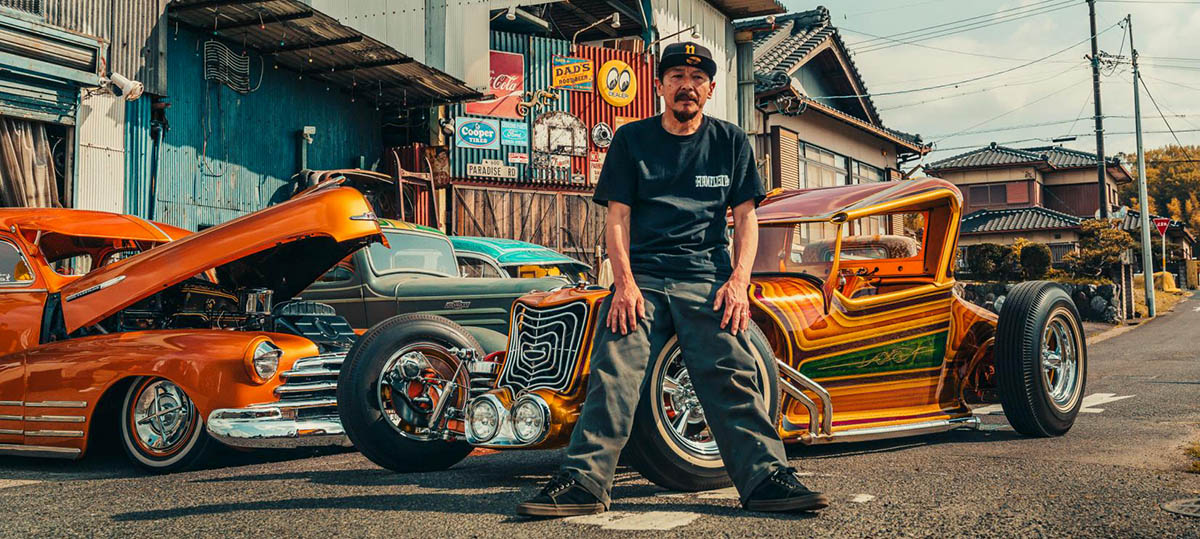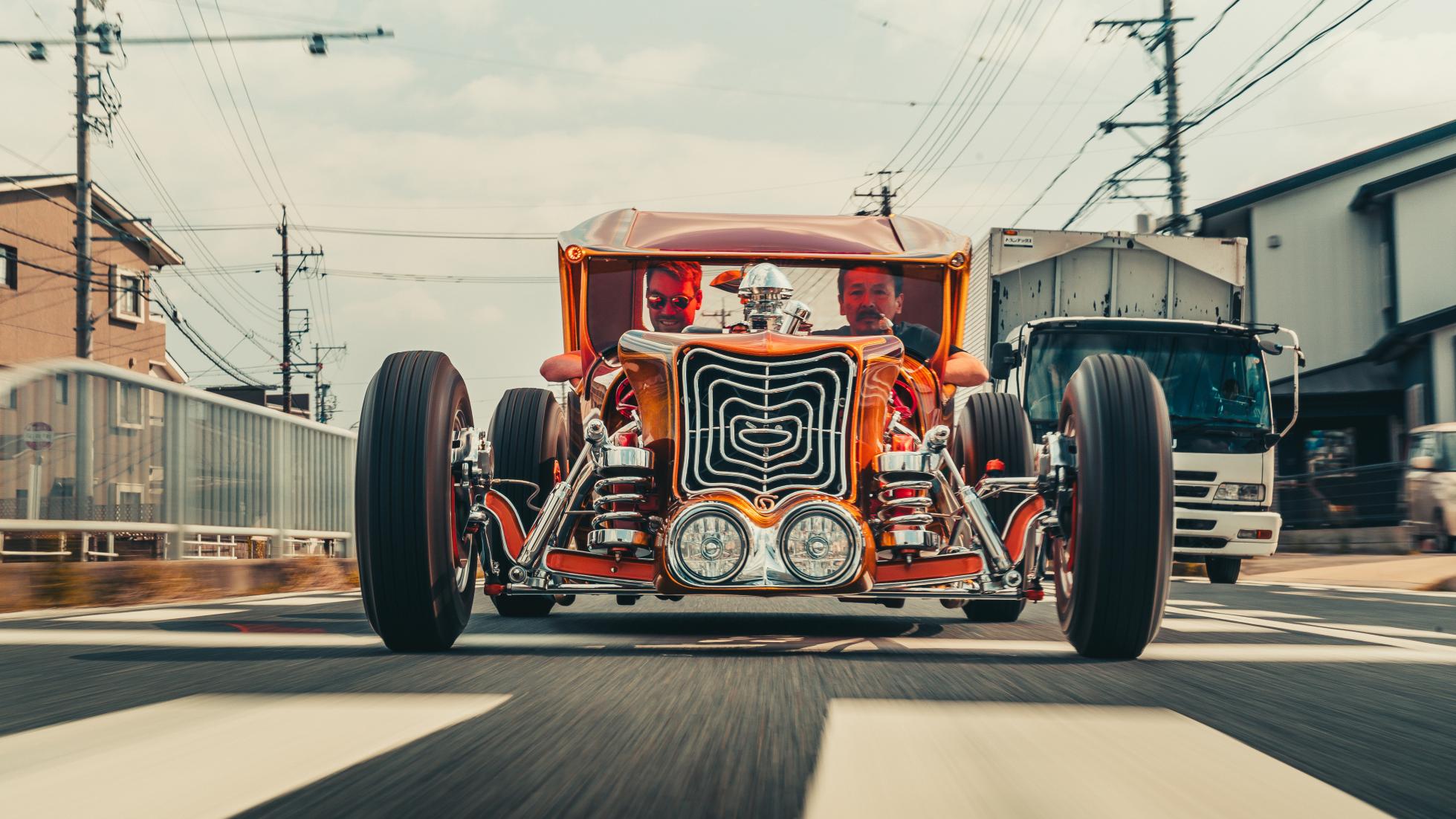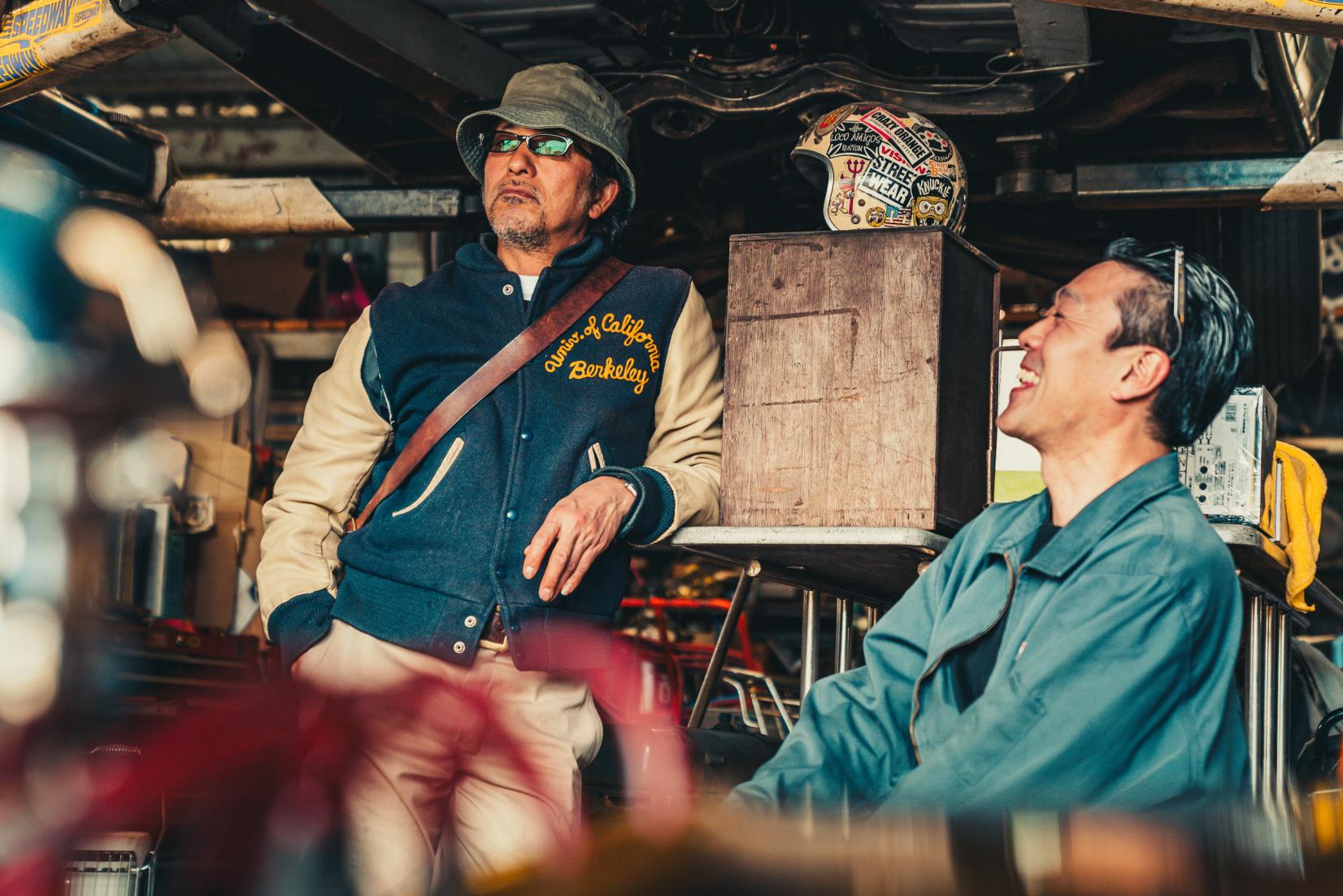Check out Japan's awesome lowriding culture


















You have to rewind back to fifties Southern California to find the not-so-humble beginnings of lowriding. Back then, young Mexican Americans (Chicanos) in Los Angeles started using their cars not as a source of transport, but ethnic statements. See, during the economic boom post-WWII, a lot of white Americans were hot rodding (jacking cars up and slotting the biggest engine they could find in them), but wanting to refuse the notion of being Anglicised, Hispanic communities did the exact opposite, as a four-wheeled F-you.
They’d chop springs or lob bags of cement in the boot to slam their cars to the ground. Then drive slow in an act of nonconformity and rebellion. Or, purely because they had big bags of cement in the boot. But they’d also go overboard with the details; adding intricate emblems, vibrant candy paintwork and elaborate airbrushed murals showcasing Mexican-American religious imagery and symbolism. At this point they were no longer cars, they were art.
From the Sixties onwards, this new culture of ‘lowriding’ continued to develop and helped harness a community for LA’s Chicanos; it brought families together, created car clubs and was used as a way to give back. Over the years, the strict aesthetic style of lowriders has become synonymous with Los Angeles and is associated (often wrongly) with violence as the scene was harboured within East LA – one of the fearsome and violent ganglands in America. It’s also risen rapidly in popularity, especially during hip hop’s G-funk era where Snoop Dogg helped PR lowriders to the world via MTV. With wild hydraulics, Dee-ohh-double-gee bounced his way around with Dr Dre ‘hittin’ switches’ to help spread the lowrider love to a whole new generation.
But, somewhat weirdly, lowriders and Chicano culture has transgressed and found a new spiritual home in Japan. Somewhere very, very far away from lowriders’ Hispanic roots, and even further away from the LA oppression that birthed it. To find out why, we spent some time with some of the main players in Nagoya, Tokyo and Chiba to try and work out why such a seemingly alien culture fits so well within the strict constraints of Japan.



Junichi Shimodaira: Owner, Paradise Road
59-year old Junichi Shimodaira is one of the founding fathers of Japan’s lowrider scene. Perched against a chromed wheel in a New Era cap, baggy T-shirt and oversized Dickies chinos, he doesn’t look a bit like your typical middle-aged man from Japan. It’s like he’s got a Japanese exterior but Mexican motherboard running him. He’s efficient, technical but also relaxed and welcoming. Something solidified as he hands me a cold can of Tecate.
“Growing up I watched a TV programme where they showed a picture of a car,” he recalls. “It was gorgeous – unlike anything I’d seen before. I later learned it was a ‘lowrider’. It was 1981, so waaaayyy before the internet and I wanted to know more. So I started reading American car magazines and watching lots of American films; Cheech and Chong, American Graffiti, that kind of thing. They all had these crazy cool cars that we’d never seen before in Japan. So, in 1987 – aged 27 – I went to LA for the first time. I couldn’t speak much English, but I found lowriders and my jaw hit the floor. The stance, amazing paint and tiny wire wheels were mind-blowing. I took a lot of photos and made a lot of friends. But I wanted to bring that style back to Japan.”











Paradise Road: Home of the Pharoahs
Junichi returned with bags full of West Coast swag and set up a little shop – Paradise Road – in Nagoya. 32 years later, it’s still running, albeit in a bigger location in the Meitō-ku district and is home to the Pharaohs car club, Japan’s oldest lowrider club, of which Junichi is president.
Paradise Road is an absolutely impenetrable Aladdin’s cave of automotive Americana. Every available inch inside the enormo corrubox is scattered with rare car parts and memorabilia, while Mexican lowrider imagery and stickers fill the gaps like some sort of south-of-the-border grouting. Upstairs, there are enough parts to build your own car from scratch. While outside, a steady stream of mates – more baggy T-shirts and slip-on Vans – perpetually rock up in custom hot rods and lowriders to smoke cigarettes, shoot the breeze and listen to rockabilly tunes from the Sixties jukebox.







The Galaxian: 1927 Ford Model T
“I always respected America’s Sixties Kustom Kulture,” Junichi says. “People like Von Dutch and Ed “Big Daddy” Roth didn’t seem constrained by anything – the cars they made were wild and looked to the future. I wanted to see if Japan could do that with some added lowrider flair.” Over the years, Junichi has built a few cars, but Galaxian – a wild 1927 Ford Model T – is his crowning glory. With bamboozling proportions, perfect stance and wild angles, it’s pure Wacky Races.
But this is no spit ‘n’ shine show car – Junichi throws me in the bathtub-esque passenger seat, thunks the hinged roof down on my head and fires the big Chevy V8 up. Leaving the shop in a one-tyre fire, he cackles behind the wheel as smoke fills the cabin. I’ve honestly never been in anything quite so terrifying. The steering has more play in it than a puppy and I’m pretty sure the brakes aren’t connected. But I don’t care as I’ve never been in anything quite as outrageous.








Ushida-san: Owner, Cholo’s Customs
“It’s an endless project,” Hisashi Ushida says looking into the wild silvers, soft blues, deep purples and pretty pinks of his 1954 Chevrolet 210, ‘Sphinx’. “I’ve been working on it for 20 years and it’ll never be done.” Ushida has owned Cholo’s Custom in Aichi’s Ama City since 2003. He is Japan’s second generation of lowriding, having been Junichi’s apprentice before going it alone. “There’s no competition between us and Paradise Road. It’s all love. We’re in it to help each other out – we’re family.”
















La Bomba Toy Drive: Where community and respect shine
To see how big this Japanese Chicano family is, we’re invited to a ‘Toy Drive’ organised by the Japanese chapter of the Old Memories Car Club. It’s a charity cruise (to help wash away the stigma that lowriders are just for gangsters), specifically for ‘Bombs’ – pre-1955 cars loaded with period options that are a nod to the first wave of customs in the Thirties.
The scale of the Japanese lowriding scene really comes into focus when we arrive at the meeting point. More than 80 incredible cars show up and, unlike most Japanese social occasions, there’s no formal bowing or confusing business card rituals – it’s all fist bumps and man hugs. It’s a family affair, too. Wives, girlfriends and mini Chicano children running around and chatting with full-face smiles and boundless respect for each other.
“The public see us as ‘bad boys’,” Old Memories president ‘Masa’ Watanabe, says. “People fear us in the streets, but there’s no violence at all – there’s not even the rivalry between clubs that you get in the USA.” But where the LA scene has its grey area of gang affiliation, arguably so does Nihon’s… even if it’s in the past.
“You see him over there?” Masa says while pointing into the distance. “Bōsōzoku. Him? Bōsōzoku. Him? Bōsōzoku. Me? Bōsōzoku.”
Back in the day, ‘Bōsōzoku’ motorbike and car gangs caused chaos in order to show their unrest for Japanese societal affluence post-WWII. It all sounds rather familiar to the early days of lowriders, doesn’t it? Well, then it’s no coincidence that these ex-Bōsō are now the top brass of Japan’s lowriding scene.
But the sheer amount of effort that’s invested into being just like their LA brethren is, quite frankly, remarkable. The cruise ends with each car club holding a barbecue and having beers. But it’s not Japanese food, rather hamburgers (flipped with chopsticks), guacamole and imported beers drunk from red cups. The imagery couldn’t be more perfect to sum up this incredible fusion car scene.
As the spring sun peeps out from behind a cloud, it’s like the Chevy’s paint suddenly ramps up the dazzle-o-meter like it’s done a line of booger sugar. It’s enchanting. And hands down the best paintjob I’ve ever seen. Given the Japanese work ethic and mindset of continuous improvement, this isn’t a surprise. “Japan is a very conservative nation. We’re not very good at being creative – y’know, thinking outside the box. But we like to take ideas and make them better. That’s why the Americans are now looking at how we’re doing things.”






Hoppers: Reach for the sky
There’s plenty of visual stimulation on offer in downtown Tokyo, but things get cranked up a notch when Pride Hops Car Club start bouncing around Shibuya. They form part of probably the most recognisable splinter of lowriding culture: Hoppers.
Running on switch-operated hydraulic suspension, the way these magnificent glitzy feats of engineering bounce, hop and tripod around on their tiny 13-inch wire wheels (a lowrider commandment) is one of motoring’s great spectacles.
You can trace the roots of Hoppers back to the late Fifties when lowriding pioneer Ron Aguirre recycled hydraulic parts from WWII fighter planes in order to adjust the ride height of his custom Corvette, X-Sonic. Nowadays, cars are built for chassis-snapping bouncing, often beyond 6ft high and sometimes toppling back on themselves like a drunkard. But the ’64 Impala is still seen as king of the (bouncy) castle. But to complete the look you need a highly flammable velour interior, twin captain’s chairs and a tiny chain steering wheel. Lovely.
The Generation Game
Lowriding isn’t just a fad in Japan. Now in its fourth generation, the Chicano cultural exchange continues to be handed down and absorbed. Kids of car club members are modifying JDM trucks to look like lowriders (just like their parents did in the Eighties) in the hope that one day they too can afford American metal.







The Future: Face tats and enviably exquisite detail
“I am nothing to do with a gang,” Genbu, the owner of an utterly stunning 1965 Buick Riveria tells me while taking a toke of a cigarette. “I just think these tattoos are cool. They tell my story – my struggle.”
He’s covered in ink. As is his friend, Taku Kawakami. Which, considering tattoos still have huge social stigma (having been outlawed in Japan due to their links to organised crime), is a bold move. But these guys are the next step. They’re the ones that are pushing social boundaries through lowrider culture – just like the Chicanos in LA back in the Fifties.
But what’s getting them there is very Japanese. It’s their obsessive otaku nature, the Japanese trait of neurotically investing time and effort into a single passion. Genbu’s Buick is a perfect example. He’s sunk over $100k into it to get air suspension, impeccable hand engravings and painstaking paintwork (it took five months). But this masterful Japanese way of excellence – plus the adoption of the Chicano culture as a whole – has created a loop across the Pacific.
Having seen the irrefutable dedication and that they’re not just a bunch of Asian Walter Mittys, the American scene has come to appreciate what Japan is doing and supports them. But where the Japanese have been copying LA lowriders for the last 40 years, ironically, some are now creating better examples of the originals they’re trying to imitate. Now, is that flattery? Or flat-out wrong? We’ll let you decide.

